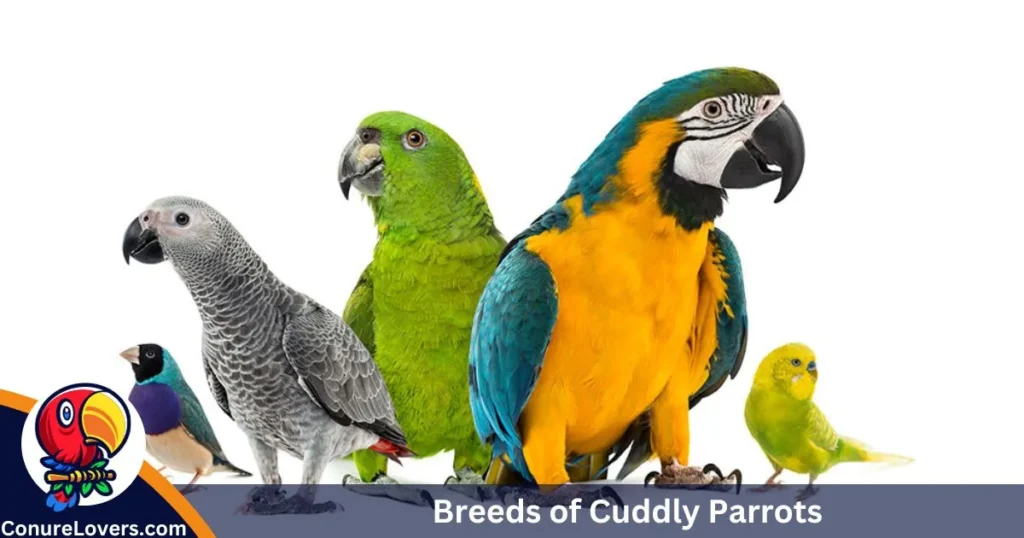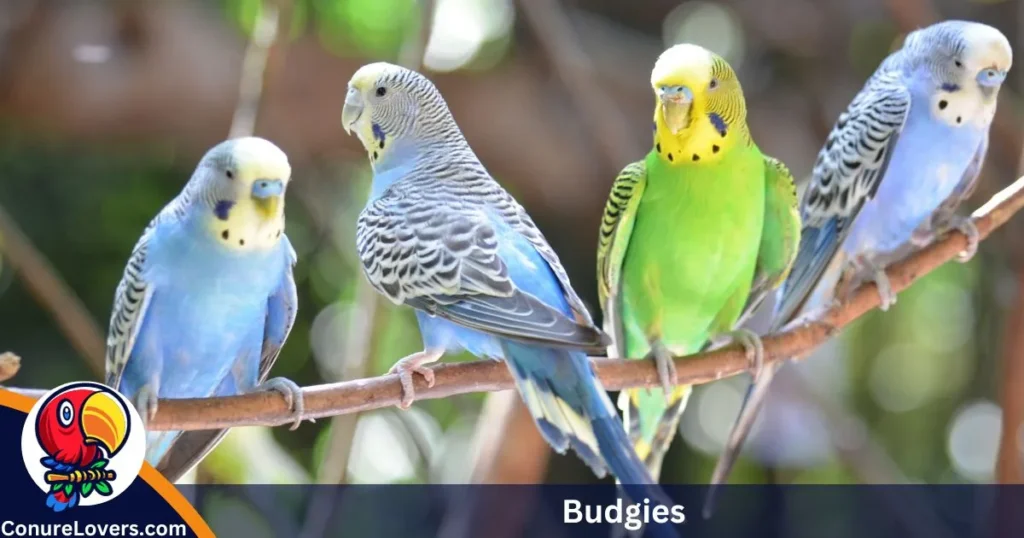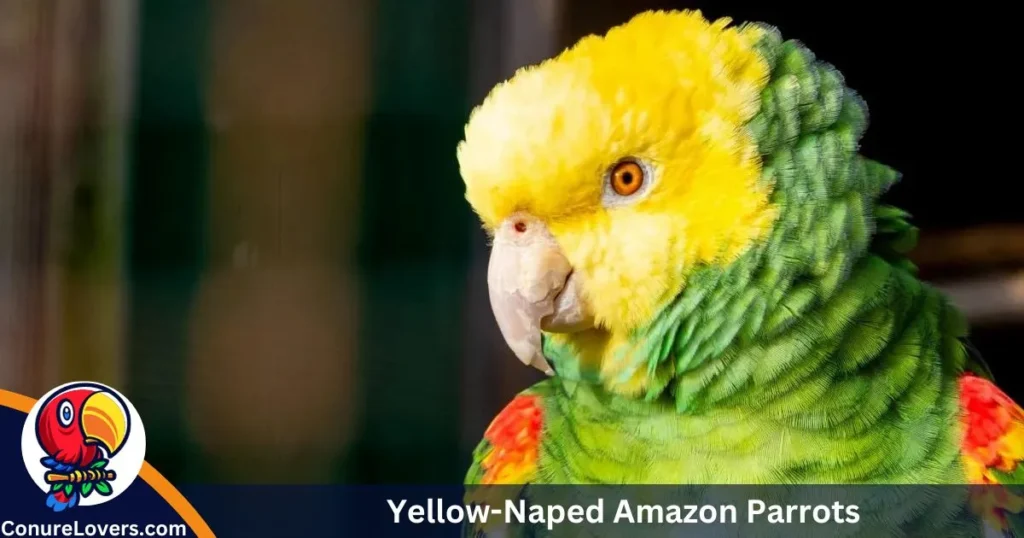Most Cuddly Parrots, Cockatiels, Hyacinth Macaws. Cockatoos, Sun Conures, Budgies, Eclectus Parrots Quakers, Senegal Parrots, senegal parrot
If you’re into the idea of having a parrot as a buddy and wonder which ones are the cuddliest, it’s a bit tricky. Different owners of the same type of parrot might have different opinions – some swear their parrot is a cuddle bug, while others claim theirs is a bit feisty.
It’s not accurate to say all cockatiels or all budgies are cuddly. Each parrot has its unique personality, showing both affection and, sometimes, a bit of attitude.
9 Breeds of Cuddly Parrots

Cockatiels
These little birds adore being touched by their owners and might even ask for head and cheek scratches. Cockatiels are low-maintenance and quickly form a strong bond with their owners. However, don’t expect them to be cuddly or playful with strangers. They’re generally content with one trusted person for companionship.
Cockatiels are smart, and forming a connection with them is a breeze. Spend time with them, teach a few tricks, and offering treats by hand can show you’re a reliable friend. The best time to build this bond is on their first day, but if you get an older one, you might need to follow specific methods to tame them.
When you bring your cockatiel home, avoid putting too much pressure on them. Let them adjust to the new environment, observe their surroundings, and avoid anything that might frighten them. Don’t ignore them; instead, talk to them in a soothing tone, making sure they hear your voice.
Cockatiels hail from Australia, growing to around 13 inches in height and weighing between 70-120 grams. They belong to the Cockatoo Family and, with proper care, can live up to 25 years. In the wild, they usually don’t exceed 15 years of age.
Read Also: The Ultimate List – 250 Safe And Toxic Foods For Parrots
Hyacinth Macaws
Hyacinth Macaws, the world’s largest parrot species, are unfortunately endangered. Originating from Brazil and Bolivia, these majestic birds can reach a whopping 40 inches in length and weigh approximately 1.2-1.7 KG (2.6-3.7 lb). Despite their imposing appearance with distinctive eyes surrounded by yellow skin, they are known as the most affectionate members of the macaw family, earning them the nickname “gentle giant.”
These striking blue parrots are particularly affectionate towards their mates, often covering them with their wings. In captivity, they display a fascination with humans, observing our actions and seemingly enjoying our company.
When bonded with their owner, the Hyacinth Macaw can transform into a lovely and friendly companion, exhibiting rare aggressiveness. They are highly social birds, demanding attention and interaction from their owners. Leaving them alone is generally not an option unless they have a mate of their own kind.
A noteworthy characteristic of Hyacinth parrots is their quiet nature. They also tend to be obedient, adding to their desirable traits. However, due to their complexity, these parrots may not be the best choice for beginners. If you’re an experienced parrot enthusiast, the Hyacinth Macaw could be the perfect cuddly companion for you.
Cockatoos
Cockatoos are a popular kind of pet parrot. They come from places like Oceania and Southeast Asia. These birds are mostly white with a cool crest on their heads. They can grow to about 25 inches tall, weigh around 1.7 lbs, and live for a long time, like 40-60 years.
But here’s the catch: Cockatoos aren’t great for new bird owners. They’re super social and get super attached to their owners. If the person they like isn’t around or doesn’t give them enough attention, they might start acting out – screaming, feeling sad, getting too aggressive, or even plucking out their feathers.
Think of Cockatoos like a commitment. Once they like you, they really like you. But, if you give them lots of attention, you’ll be surprised how these birds, full of energy and love for playing and cuddling, can become awesome friends.
Just so you know, Cockatoos don’t usually fit well with families. They pick one person to love and might not be too friendly with others in the family. They could bite or not let others play or cuddle with them. Bonding with a Cockatoo is all about spending time together and playing. If you’re living alone and want a cuddly bird, a Cockatoo could be a great choice. Just make sure you have enough experience, patience, and time for them.
Sun Conures
Sun Conures hail from northern Brazil, Venezuela, and Guyana. They’re a breeze to train, reaching about 12 inches in height and weighing 110 grams. With proper care, these vibrant birds can live up to 30 years and quickly form strong bonds with their owners.
Conures are super loyal and make excellent family birds. They can handle the presence of multiple family members without showing aggression, as long as they’re familiar. In the wild, they’re incredibly social, often forming large colonies. This social nature carries over to home life, where they thrive on attention and interaction from their owners.
Known for being one of the loudest pet parrots, Conures are also extremely playful and cuddly. They enjoy playing with toys, water, and especially their owners. If you think you can get work done while they’re around, think again. These parrots will keep you on your toes and might just annoy you a bit with their lively antics!
Budgies

Budgies, native to Australia, can grow up to 7 inches and weigh about 25-30 grams. With proper care, they can live up to 10 years. Despite their small size, they are quite sensitive and can get scared easily, which might even lead to unfortunate outcomes.
Forming a bond with a Budgie takes time, especially if you have more than one bird. Once bonded, don’t expect them to be overly cuddly in your way. They show affection in their unique style, allowing you to touch their cheek for a scratch. They also enjoy perching on your shoulders and fingers, often preferring it over their cage.
If your Budgie has bonded with you, they might not be super cuddly, but they do love interacting with humans. They are relatively easy to care for and can be an excellent choice for beginners, provided there’s no pressure in the interaction.
Eclectus Parrots
Eclectus are medium-sized parrots hailing from the Solomon Islands and nearby areas. They can reach a height of 12-14 inches and weigh about 400-500 grams, with a lifespan of around 40 years when in captivity.
Interestingly, scientists initially believed that male and female Eclectus were entirely different parrot species due to their distinct colorations. Male Eclectus have predominantly green feathers with red patches under their wings and bright orange beaks. In contrast, female Eclectus sport mostly red feathers with blue ones on the chest and around the neck, along with a black beak.
These parrots are highly intelligent, gentle, and caring. They are among the quieter parrot species, and they love to cuddle and play with their owners, forming strong bonds. However, it’s essential to manage these bonds, especially if you have a pair of Eclectus. They need dedicated time either with their owner or their cage mate. Additionally, they require special attention to their diet.
Quakers
Quaker parrots, native to Australia, can grow up to 12 inches with a body weight of 100 grams. In captivity, they can live up to 30 years. These parrots are incredibly social and can form strong bonds with their owners if given enough time together.
Known for their intelligence, Quakers often bond closely with one family member but are generally friendly with strangers due to their high social interaction needs. They have bold personalities and can become super cuddly with their owners. If you notice aggression or biting, don’t worry too much—it’s often normal behavior for them.
To strengthen your bond with your Quaker, talk to them and let them hear your voice. Trying to teach them tricks, like stepping up on your hand or another object, can also be a fun way to interact.
While there’s a common assumption that these birds are easy to care for, the reality is that they require a substantial amount of time and experience. An inexperienced owner might face challenges, leading to behavioral disorders like aggression, biting, or even depression in Quakers.
It’s crucial to note that Quakers are illegal in some states, so it’s essential to check the regulations in your area.
Senegal Parrots
This parrot breed is originally from central and western Africa, weighing approximately 130-180 grams and standing up to 9 inches tall. In the wild, they usually live around 30 years, but with proper care in captivity, they can reach up to 50 years. Senegal parrots may initially have some fear of humans, especially if they are still wild or spent most of their lives in cages. To ensure a cuddly Senegal parrot, it’s crucial to get them at a very young age or at least acquire a well-socialized bird.
Meeting these two requirements is essential, and with them, you can expect a very cuddly, affectionate, and playful pet companion. Senegal parrots are intelligent and have the ability to keep their owners entertained. Although not widely known, owners claim that this bird is easy to care for and easy-going. If you’re seeking a super cuddly parrot, considering this breed might be a great idea.
Yellow-Naped Amazon Parrots

Yellow-naped Amazon parrots are originally from Mexico and northern South America. In the wild, they can live up to 30 years, but in captivity, they might reach an impressive age of 80 years. Growing to about 14 inches tall and weighing approximately 450-650 grams, these parrots are known as some of the best talkers among their kind. When hand-fed by owners from a young age, they tend to form strong bonds and become affectionate, cuddly pets. However, it’s important to note that they demand a significant amount of time and attention from their owners.
Male individuals of this breed may transition from being affectionate to displaying some aggression and biting as they age. Due to their complex nature, Yellow-naped Amazon parrots are not the best choice for beginners.
Conclusion
The cuddliness of parrots depends on several factors. If you meet a parrot later in its life, don’t expect it to be naturally cuddly. In such cases, you might need to tame them first and see if bonding happens over time.
Parrots tend to show affection if they bonded with their owners early in life. Getting a baby parrot that needs hand-feeding can result in a cuddly, playful, and loyal companion. This also increases the likelihood of the parrot flying freely but staying close. Ideally, we’re talking about chicks that are 2-3 months old or younger.
Diet plays a crucial role; each parrot breed has unique dietary requirements. Failing to meet these requirements can lead to behavioral issues. Educate yourself on the ideal diet for your specific parrot, taking into account molting and breeding times, which can also impact their behavior and nutritional needs.
Housing matters too. Place the cage in a spot where your parrot can observe you, your family, and the surroundings. Most parrots are social and prefer locations that keep them stimulated. Isolating them in a quiet area may lead to depression and anxiety, negatively affecting their behavior.
To keep your parrot happy, provide interesting and chewable toys. This can contribute to their satisfaction and overall well-being.

Nicholas Clark here, your Easy Conure Care Guide at “Conure Lovers.” I’m here to simplify conure care for you. Let’s navigate the basics together, ensuring your feathery friend enjoys a colorful and chirpy life.












